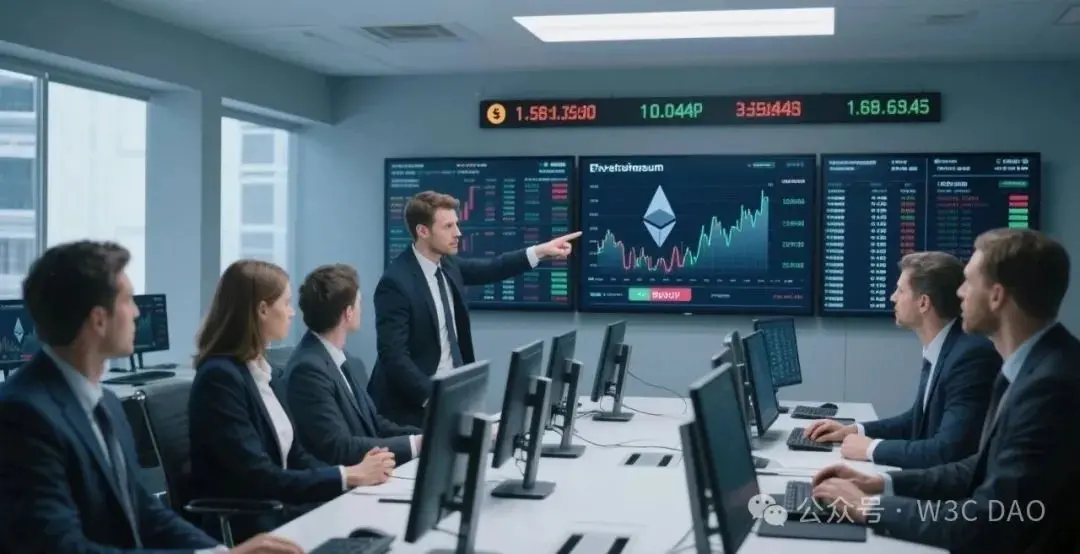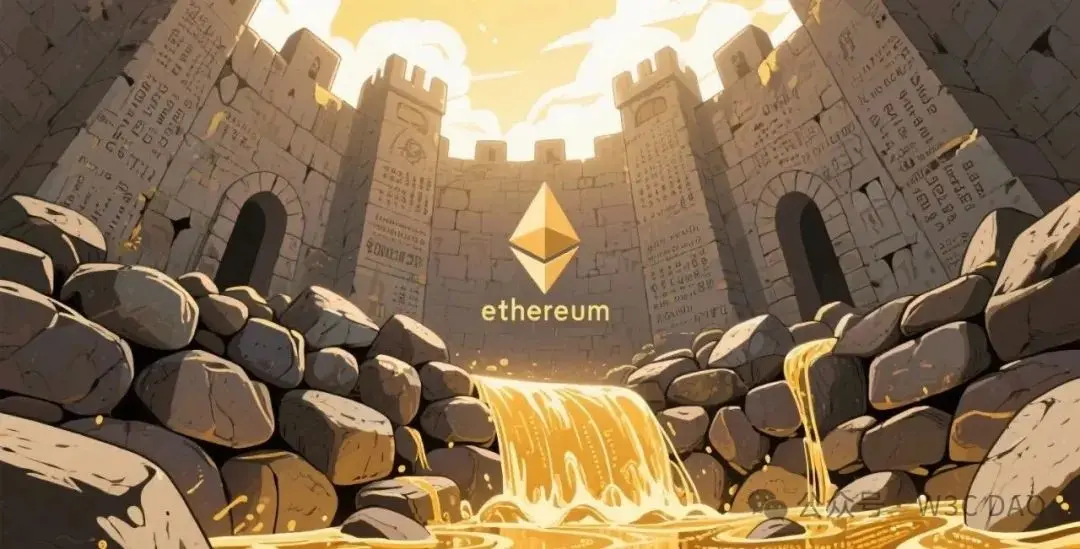Author: Martin, W3C DAO
At the end of June 2025, a publicly traded company named BitMine Immersion Technologies launched an Ethereum treasury plan, increasing its holdings by over 135,000 Ethereum in the past 10 hours, bringing its total holdings to over 1.3 million Ethereum. The company's chairman, Thomas Lee, publicly stated: "Our goal is to hold 5% of the world's Ethereum."
This is not an isolated case; from traditional gaming company SharpLink to investment firm BTCS, publicly traded companies are hoarding Ethereum at an unprecedented rate. Strategic ETH reserve data shows that as of August this year, the total amount of ETH held by institutions has reached 8.3% of the total supply, doubling from 3% in early April.

During the same period, the price of Ethereum soared from $1,385 to $4,788, with daily trading volume climbing to the range of $4.5 to $4.9 billion. Wall Street analysts began referring to ETH as "digital oil"—both the energy driving the blockchain economy and an indispensable strategic reserve in institutional asset allocation.
I. Institutional Hoarding Frenzy: Ethereum Becomes the "New Gold" for Corporate Treasuries
In 2025, a flood of capital from Wall Street is pouring into Ethereum at an unprecedented pace. The latest data shows that the proportion of ETH held by corporate treasuries and ETFs has surpassed 8.3% of the total supply, doubling from 3% at the beginning of the year, equivalent to approximately 10 million ETH locked in institutional vaults. Three major players stand out:
• Bitmine Immersion Tech (formerly a Bitcoin mining company) has accelerated its Ethereum micro-strategy, increasing its holdings by over 135,000 Ethereum in the past 10 hours, bringing its total holdings to over 1.3 million, making it the largest corporate holder of Ethereum globally. Since launching its Ethereum reserve strategy on June 30, its holdings have grown from 0 to 1.3 million in just 7 weeks, averaging over 27,000 additions per day. Notably, from August 10 to 16, it added 247,000 Ethereum in a single week, worth over $1 billion! The company previously announced plans to control about 5% of the global Ethereum supply, approximately 6 million, and has already completed 21.7% of this goal, indicating that BitMine's Ethereum reserves have entered an exponential growth phase, and its aggressive strategy may lead to a new pattern of corporate Ethereum allocation.
• The latest data shows that the number of Ethereum treasury companies has reached 70, with total holdings exceeding 3.7 million, with SharpLink ranking second with over 728,000 Ethereum.
• The Ether Machine has also surpassed the 340,000 Ethereum mark.
It is expected that by the end of the year, the total corporate Ethereum holdings may exceed 8 million.

Even more astonishing is the speed of ETF fund flows. BlackRock's ETHA spot ETF has already purchased over 3.6 million Ethereum, totaling over $12 billion, while Grayscale's Ethereum ETF has purchased nearly 2 million Ethereum, totaling about $7.3 billion. In the past week, the net inflow of Ethereum ETFs was $2.85 billion, with over $1 billion net inflow on August 11 alone!
II. Technological Evolution: From Merge to Pectra Upgrade to the Digital Oil Revolution
Ethereum's market performance in 2025 is remarkable, with its underlying transformation disrupting performance ceilings. The Pectra upgrade, launched in Q1 2025, reshapes the network's framework through 12 key EIP proposals:
• EIP-7702 grants ordinary wallets "smart contract-level functionality," allowing users to achieve gas fee payments and social recovery like WeChat Pay, completely eliminating the fear of mnemonic phrases;
• EIP-7251 raises the validator staking limit from 32 ETH to 2048 ETH, tripling node communication efficiency and clearing obstacles for institutional staking;

As network activity increases, ETH burning accelerates, creating a self-reinforcing cycle of reduced supply and price support.
III. Ecological Explosion: From DeFi to RWA to Stablecoin Value Reconstruction
Ethereum is shedding its "Bitcoin's sidekick" label, evolving into the global settlement layer for trillion-dollar real assets on-chain.
RWA (Real World Assets) has become one of the strongest narratives of 2025, encompassing traditional assets such as U.S. Treasury bonds, real estate equity, and carbon credits. BlackRock's BUIDL fund has surpassed $2.4 billion, with over 90% of its assets locked in Ethereum.

The integration of DeFi and AI opens new dimensions, with AI agents autonomously executing dynamic interest rate lending strategies and optimizing MEV distribution mechanisms, attracting over 100,000 traditional developers into the ecosystem. DeFi's locked value soared to $85.9 billion in July, reaching a three-year high, with Ethereum capturing 60% of the share.
Stablecoins have solidified Ethereum's position as the "on-chain dollar," with 54% of stablecoins (approximately $137.7 billion) circulating on Ethereum, with each transaction burning ETH, reinforcing its "digital crude oil" attributes.
IV. Wall Street Trends: Why Capital Chooses Ethereum?
The most striking trend in 2025 is the large-scale incorporation of Ethereum into corporate treasury reserves. Unlike early Bitcoin, which was viewed by companies as merely a store of value, institutions see ETH as a "productive asset"—capable of generating returns through staking while also participating in the DeFi ecosystem for additional rewards.
The massive influx of institutional capital into Ethereum is driven by its irreplaceable practical value in the crypto ecosystem. Unlike Bitcoin, which primarily serves as a store of value, Ethereum has become the operational foundation of the blockchain economy.
As the core platform for tokenizing real-world assets (RWA), Ethereum held 81% of the RWA market share by the end of 2024, locking in approximately $14.9 billion in assets and serving over 80,000 asset holders. Analysts believe this will be a key factor driving Ethereum's strong growth in 2025.
As the cornerstone of stablecoin infrastructure, Ethereum holds 54% of the stablecoin market share, supporting the most successful application scenarios in the crypto space. The circulating supply of stablecoins is expected to reach $200 billion in 2024, with projections of possibly exceeding $400 billion in 2025.

Compared to Bitcoin's "digital gold" narrative, Ethereum's appeal to institutions lies in three core advantages:
Productive asset attributes: Staking ETH can yield 3-5% annual returns, making it more attractive than U.S. Treasuries during the Federal Reserve's interest rate cut cycle;
Compliance first-mover advantage: The EU's MiCA regulations classify ETH as a "compliance benchmark," and the Trump-nominated pro-crypto SEC chairman has cleared policy uncertainties;
Ecological network effects: 5,000 active DApps and 500,000 developers create a moat, with a scale five times that of competitors like Solana.
Fundstrat founder Thomas Lee asserts: "The fair value of Ethereum should be in the range of $10,000 to $15,000," while Bitwise CIO's prediction is relatively conservative: ETH will exceed $7,000 in 2025.
V. Challenges and Future: Ethereum's Path as "Digital Oil"
As Bitcoin ETFs drive the first wave of institutional interest, Ethereum is launching a more imaginative value narrative through a combination of technological breakthroughs, ecological explosions, and compliance advancements.
It is not only a better "digital gold"—it is also a productive asset connecting traditional finance and the crypto world, the settlement layer for the trillion-dollar RWA market, and the foundational infrastructure for the AI agent economy. Each additional ETH in corporate treasuries is a vote for this value reconstruction.

As Bitmine stated during its transformation: "We are betting not on token prices, but on the entire digital economy's operating system." As Ethereum sheds its old labels, a golden era for the smart contract ecosystem is just beginning to dawn.
BlackRock is holding $2.4 billion in U.S. Treasury bonds on Ethereum, and Sony is building a metaverse on Layer 2—these entries from the traditional world signify that Ethereum's "institutional narrative" is just turning the page.
The more profound impact lies in the reconstruction of financial infrastructure. As the trend of RWA (real-world assets) moving on-chain accelerates, a market opportunity worth $16 trillion is opening up, with Ethereum poised to become the core infrastructure of the next-generation financial system.
As Ethereum holds 81% of the RWA market share and 54% of the stablecoin market share, one question deserves investors' contemplation: Are we witnessing a replay of another Bitcoin story, or the beginning of a more profound "digital oil" revolution?
免责声明:本文章仅代表作者个人观点,不代表本平台的立场和观点。本文章仅供信息分享,不构成对任何人的任何投资建议。用户与作者之间的任何争议,与本平台无关。如网页中刊载的文章或图片涉及侵权,请提供相关的权利证明和身份证明发送邮件到support@aicoin.com,本平台相关工作人员将会进行核查。



